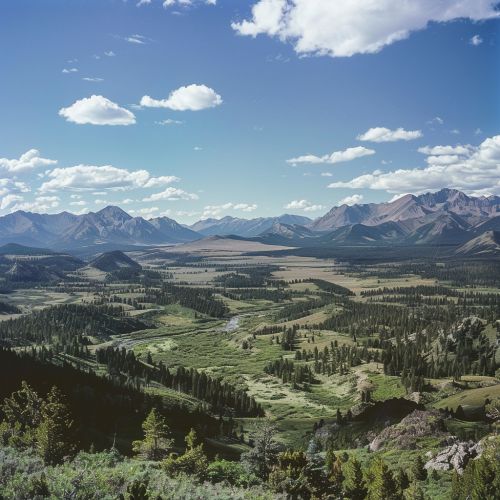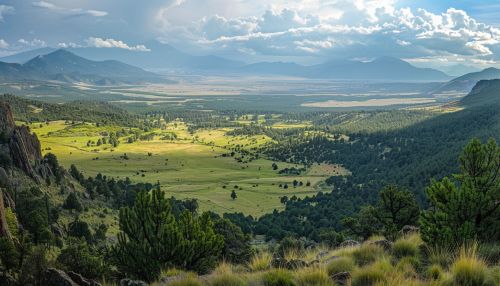Americas
Geography
The Americas, also known as America, comprise the totality of the continents of North and South America. Together, they make up most of the land in Earth's Western Hemisphere and comprise the New World. The Americas cover 8% of Earth's total surface area and 28.4% of its land area. The topography of the Americas is diverse, ranging from the Rocky Mountains and Andes to the vast plains of the Great Plains and the Amazon Basin.


North America
North America is the third-largest continent by area, following Asia and Africa. It is bordered by the Arctic Ocean to the north, the Atlantic Ocean to the east, the Pacific Ocean to the west, and South America and the Caribbean Sea to the southeast. The continent includes countries such as the United States, Canada, and Mexico, as well as the Central American nations and the island nations of the Caribbean.
Climate
The climate of North America varies significantly due to its vast size and diverse geography. It ranges from the Arctic tundra in the north to tropical rainforests in Central America. The continent experiences a variety of climatic zones, including temperate, arid, and tropical climates.
Natural Resources
North America is rich in natural resources, including minerals, forests, freshwater, and fertile soil. The continent is a major producer of petroleum, natural gas, and coal. The Great Lakes and the Mississippi River system are significant freshwater resources.
South America
South America is the fourth-largest continent by area and is located primarily in the Southern Hemisphere. It is bordered by the Atlantic Ocean to the east, the Pacific Ocean to the west, and North America and the Caribbean Sea to the northwest. Major countries include Brazil, Argentina, and Colombia.
Climate
South America's climate is equally diverse, ranging from the tropical rainforests of the Amazon Basin to the arid deserts of Chile's Atacama Desert. The continent also features temperate zones in the southern regions and high-altitude climates in the Andes.
Natural Resources
South America is known for its abundant natural resources, including vast forests, freshwater, and mineral deposits. The Amazon Rainforest, often referred to as the "lungs of the Earth," is a critical component of the global ecosystem. The continent is also a leading producer of coffee, soybeans, and other agricultural products.
History
The history of the Americas is complex and multifaceted, involving a myriad of indigenous cultures, European colonization, and the development of modern nation-states.
Pre-Columbian Era
Before the arrival of Europeans, the Americas were home to numerous advanced civilizations, including the Maya, Aztec, and Inca. These civilizations developed sophisticated systems of agriculture, architecture, and governance.
European Colonization
The arrival of Christopher Columbus in 1492 marked the beginning of European colonization. Spain, Portugal, France, and England established colonies throughout the Americas, leading to significant cultural and demographic changes. The transatlantic slave trade also played a crucial role in shaping the demographics of the continent.
Independence Movements
The 18th and 19th centuries saw a wave of independence movements across the Americas. The United States declared independence from Britain in 1776, followed by Latin American countries in the early 19th century. These movements were influenced by Enlightenment ideals and the success of the American and French revolutions.
Demographics
The population of the Americas is diverse, with a rich tapestry of ethnicities, languages, and cultures.
Population Distribution
As of the early 21st century, the Americas have a combined population of over 1 billion people. The most populous countries are the United States, Brazil, and Mexico. Urbanization is a significant trend, with major cities like New York, São Paulo, and Mexico City serving as economic and cultural hubs.
Languages
The Americas are linguistically diverse, with hundreds of indigenous languages still spoken. The primary languages are Spanish, English, Portuguese, and French, reflecting the colonial history of the continent.
Ethnic Groups
The ethnic composition of the Americas is a blend of indigenous peoples, descendants of European colonizers, African slaves, and later immigrants from around the world. This diversity is reflected in the continent's cultural practices, cuisine, and traditions.
Economy
The economies of the Americas are varied, ranging from highly developed to developing economies.
North America
North America, particularly the United States and Canada, has some of the world's largest and most advanced economies. The region is characterized by a high level of industrialization, technological innovation, and a robust service sector.
Latin America
Latin America's economies are diverse, with significant agricultural, mining, and manufacturing sectors. Brazil is the largest economy in South America, followed by Argentina and Colombia. The region has experienced economic growth but also faces challenges such as income inequality and political instability.
Culture
The cultural landscape of the Americas is rich and varied, shaped by indigenous traditions, colonial influences, and modern global trends.
Indigenous Cultures
Indigenous cultures have a profound impact on the cultural heritage of the Americas. From the art and architecture of the Maya and Inca to the spiritual practices of Native American tribes, indigenous traditions continue to influence contemporary culture.
Colonial and Modern Influences
European colonization introduced new languages, religions, and cultural practices to the Americas. Over time, these influences blended with indigenous traditions to create unique cultural identities. Modern influences, including globalization and immigration, continue to shape the cultural landscape.
